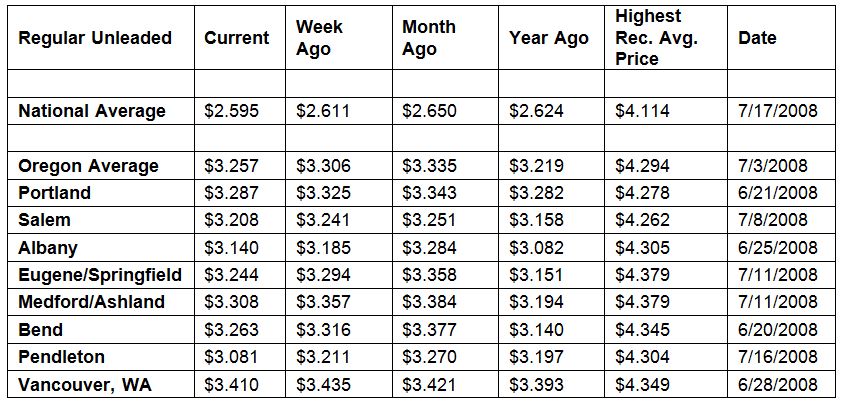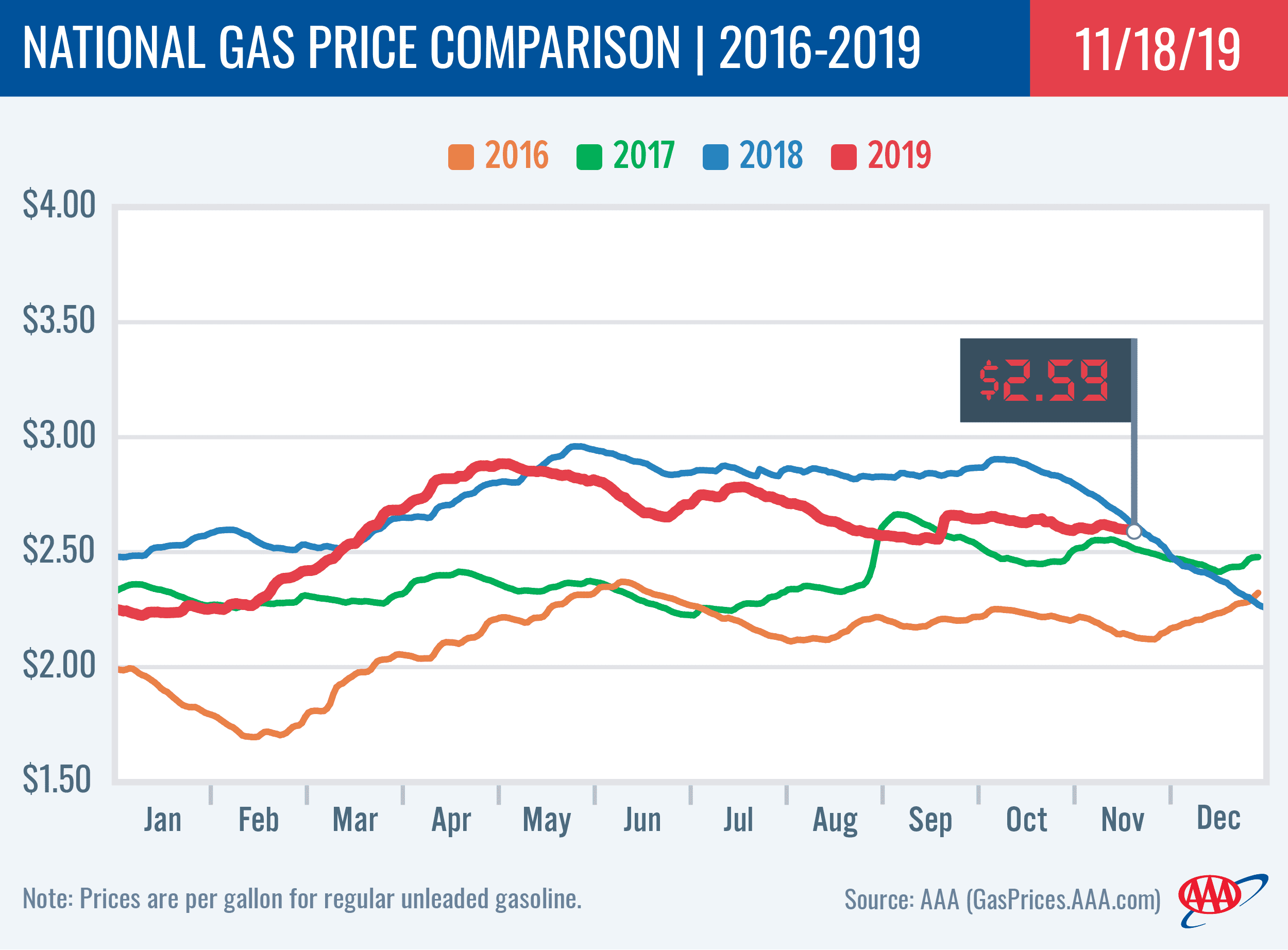Increase in Gasoline Stocks Pushes Gas Prices Cheaper
PORTLAND, Ore., – Pump prices are cheaper in most states including Oregon this week as an increase in gasoline stocks has put downward pressure on prices. For the week, the national average slips one-and-a-half cents to $2.60 a gallon. The Oregon average falls a nickel to $3.26. This is the third-largest weekly decline in the nation.
“We would expect the trend of falling gas prices to continue through this month, but the travel surge for Thanksgiving could cause price volatility and drivers could see increases at the pumps leading up to and through the holiday weekend,” says Marie Dodds, public affairs director for AAA Oregon/Idaho. AAA projects the second-highest travel volume for Thanksgiving on record with 55 million Americans traveling for the holiday including 748,000 Oregonians. The vast majority—49.3 million Americans including 643,000 Oregonians—will drive to their Thanksgiving destinations. Find details in the Thanksgiving travel news release.
Oregon is one of 39 states where prices are lower now than a week ago; As mentioned above, Oregon (-5 cents) has the third-largest weekly decline in the country. California (-9 cents) has the largest week-over-week decline, and Delaware is second (-8 cents). Ohio (+5 cents) has the biggest weekly jump, followed by Indiana (+4 cents). Prices are flat in Hawaii.
This week there are six states with an average above $3 a gallon, same as a week ago. For the last seven weeks, California has been the only state in the nation with an average above $4 a gallon. The California drops below the $4 a gallon mark this week, falling to $3.94.
Oregon is one of 41 states with lower prices now than a month ago. The national average is five cents less and the Oregon average is 8 cents less than a month ago. This is the ninth-largest monthly decrease in the nation. California (-21 cents) has the largest month-over-month decline and Michigan (-17 cents) is second. Utah (+18 cents) has the largest month-over-month increase.
Oregon is one of 15 states where drivers are paying more than a year ago. The national average is three cents less and the Oregon average is four cents more than a year ago. California (+30 cents) and Ohio (+13 cents) have the biggest year-over-year increases. Connecticut (-22 cents) has the largest year-over-year drop.
West Coast
The West Coast continues to have the highest pump prices in the nation with all of the region’s states landing on the top 10 most expensive list.
| Rank | Region | Price on 11/19/19 | |
| 1 | California | $3.94 | |
| 2 | Hawaii | $3.66 | |
| 3 | Washington | $3.38 | |
| 4 | Nevada | $3.35 | |
| 5 | Oregon | $3.26 | |
| 6 | Alaska | $3.20 | |
| 7 | Idaho | $2.99 | |
| 8 | Arizona | $2.94 | |
| 9 | Utah | $2.94 | |
| 10 | Colorado | $2.80 |
California is most expensive for the ninth week in a row, with Hawaii, Washington, Nevada, Oregon, and Alaska rounding out the top six. Oregon is fifth most expensive for the 18th week in a row. Arizona is eighth.
Pump prices in the West Coast region have decreased on the week. Prices spiked in the region earlier this fall after planned and unplanned refinery maintenance reduced supplies amid robust demand. Prices continue to ease as a result of imports to the region and increased production from regional refineries. As supply increases, prices will likely continue to drop throughout the region this week.
The EIA report for the week ending November 8 showed that total West Coast gasoline stocks increased from 26.19 million bbl to 26.60 million bbl. The current level is approximately 100,000 bbl lower than last year’s level at this time.
The cheapest gas in the nation can be found in Mississippi ($2.22) and Louisiana ($2.22). For the 40th week in a row, no states have an average below $2 a gallon.
Oil market dynamics
Crude oil prices increased last week due to increased optimism that China and the U.S. – the world’s two largest crude consumers – are continuing to resolve ongoing trade tensions that sparked market fears that global crude demand would suffer as a result of increased tariffs between both countries. Crude prices increased despite new data from EIA that revealed total domestic crude inventories increased by 2.2 million bbl, bringing the new total to 449 million bbl. The current level is 6.9 million bbl higher than last year’s level at this same time.
At the close of Friday’s formal trading session on the NYMEX, WTI increased by 95 cents to settle at $57.72. At the close of Monday’s formal trading session on the NYMEX, WTI fell 67 cents to close at $57.05. Today crude is trading around $56, compared to $57 a week ago. Crude prices are up about five percent in the last month and are about $1 per barrel more than a year ago.
Drivers can find current gas prices along their route with the free AAA Mobile app for iPhone, iPad and Android. The app can also be used to map a route, find discounts, book a hotel and access AAA roadside assistance. Learn more at AAA.com/mobile.
Diesel
For the week, the national average holds steady at $3.01 a gallon. Oregon’s average loses two cents to $3.48. A year ago the national average for diesel was $3.22 and the Oregon average was $3.40.
Find current fuel prices at GasPrices.AAA.com.
AAA news releases, high resolution images, broadcast-quality video, fact sheets and podcasts are available on the AAA NewsRoom at NewsRoom.AAA.com.
Find local news releases at https://www.oregon.aaa.com/category/news-releases/



